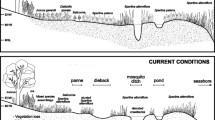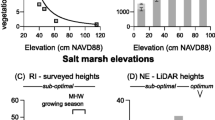Abstract
Salt pools are water-filled depressions common to north-temperate salt marshes. In Wells, ME, USA, cores reveal a unique salt pool signature consisting of water-saturated dark-gray mud often containing fragments of Ruppia maritima. Cores through pool sediment reenter salt marsh peat, not tidal flat sediment, demonstrating that most pools are of secondary origin. A principal component analysis of attribute data collected from 119 pools defines three distinct pool types: those with (1) surrounding high-marsh vegetation and thick heavily undercut banks (40% of the variance), (2) surrounding low-marsh vegetation and thicker slightly undercut banks (18% of the variance), and (3) surrounding low-marsh vegetation and less thick moderately undercut banks, containing R. maritima and a surficial drainage (15% of the variance). Cores and spatiotemporal analyses of aerial photographs between 1962 and 2003 reveal dramatic salt marsh surface dynamism suggesting that salt pools influence the geomorphological evolution of coastal marshes.









Similar content being viewed by others
References
Adamowicz, S.C. and C.T. Roman. 2005. New England salt marsh pools: A quantitative analysis of geomorphic and geographic features. Wetlands 25: 279–288.
Argow, B.A. and D.M. FitzGerald. 2006. Winter processes on northern salt marshes: Evaluating the impact of in-situ peat compaction due to ice loading, Wells, ME. Estuarine, Coastal and Shelf Science 69: 360–369.
Baily, B. and A.W. Pearson. 2007. Change detection mapping and analysis of salt marsh areas of central southern England from Hurst Castle spit to Pagham Harbour. Journal of Coastal Research 23: 1549–1564.
Belknap, D.F., B.G. Andersen, R.S. Anderson, W.A. Anderson, H.W. Borns Jr., G.L. Jacobson Jr., J.T. Kelley, R.C. Shipp, D.C. Smith, R. Stuckenrath, W.B. Thompson, and D.A. Tyler. 1987. Late quaternary sea-level changes in Maine. In Sea-level fluctuation and coastal evolution. Special publication 41, ed. D. Nummedal, O. Pilkey, and J.D. Howard, 71–85. Tulsa: Society of Economic Paleontologists and Mineralogists.
Belknap, D. F., R. C. Shipp, R. Stuckenrath, J. T. Kelley, and H. W. Borns, Jr. 1989. Holocene sea-level change in coastal Maine, p. 85-106. In W. A. Anderson and H. W. Borns, Jr. (eds.), Neotectonics of Maine. Maine Geological Survey Bulletin, No. 40.
Boston, K.G. 1983. The development of salt pans on tidal marshes with particular reference to south-eastern Australia. Journal of Biogeography 10: 1–10.
Byrne, R.J. and J.M. Ziegler. 1977. Coastal engineering study: Wells Harbor, Maine. Waltham: Department of the Army, New England Division, Corps of Engineers. 89 pp.
Cavatorta, J.R., M.E. Johnston, C.S. Hopkinson, and V. Valentine. 2003. Patterns of sedimentation in a slat-marsh dominated estuary. Biological Bulletin 205: 239–241.
Chapman, V.J. 1960. Salt marshes and salt deserts of the world. New York: Interscience.
Day Jr., J.W., L.D. Britsch, S.R. Hawes, G.P. Shaffer, D.J. Reed, and D. Cahoon. 2000. Pattern and process of land loss in the Mississippi Delta: A spatial and temporal analysis of wetland habitat change. Estuaries 23: 425–438.
DeLaune, R.D., J.A. Nyman, and W.H. Patrick Jr. 1994. Peat collapse, ponding and wetland loss in a rapidly submerging coastal marsh. Journal of Coastal Research 10: 1021–1030.
ERDAS IMAGINE. 2006. Version 8.7, Leica Geosystems GIS and Mapping, LLC., Atlanta, Georgia, USA.
Ewanchuk, P.J. and M.D. Bertness. 2004. Structure and organization of a northern New England salt marsh plant community. Journal of Ecology 92: 72–85.
Gehrels, W.R. 1994. Holocene sea-level changes in the northern Gulf of Maine: regional trends and local fluctuations determined from foraminiferal analyses and paleotidal modeling. Orono, Maine: University of Maine, Ph.D. thesis, 337 pp.
Harshberger, J.W. 1916. The origin and vegetation of salt marsh pools. Proceedings American Philosophical Society 55: 481–485.
Hartig, E.K., V. Gornitz, A. Kolker, F. Mushacke, and D. Fallon. 2002. Anthropogenic and climate-change impacts on salt marshes of Jamaica Bay, New York City. Wetlands 22: 71–89.
Jacobson, H.A. and G.L. Jacobson Jr. 1987. Variability of vegetation in tidal marshes of Maine, U.S.A. Canadian Journal of Botany 67: 230–238.
Kearney, M.S., R.E. Grace, and J.C. Stevenson. 1988. Marsh loss in Nanticoke Estuary, Chesapeake Bay. Geographical Review 78: 205–220.
Kelley, J.T., W.R. Gehrels, and D.F. Balknap. 1995. Late Holocene relative sea-level rise and the geological development of tidal marshes at Wells, Maine, USA. Journal of Coastal Research 11: 136–153.
Kelley, J.T., D.F. Belknap, and J.F. Daly. 2001. Comment on “North Atlantic climate-ocean variations and sea level in Long Island Sound, Connecticut, since 500 cal yr A.D”. Quaternary Research 55: 105–107.
Kirwan, M.L., A.B. Murray, and W.S. Boyd. 2008. Temporary vegetation disturbance as an explanation for permanent loss of tidal wetlands. Geophysical Research Letters. doi:10.1029/2007GL032681.
MacKenzie, R.A. and M. Dionne. 2008. Habitat heterogeneity: Importance of salt marsh pools and high marsh surfaces to fish production in two Gulf of Maine salt marshes. Marine Ecology Progress Series 368: 217–230.
Mandracchia, M.A. and E. Ruber. 1990. Production and life cycle of the gastropod Hydrobia truncata, with notes on Spurwinkia salsa in Massachusetts salt marsh pools. Estuaries 13: 479–485.
Master, T.L., J.K. Leiser, K.A. Bennett, J.K. Bretsch, and H.J. Wolfe. 2005. Patch selection by snowy egrets. Waterbirds 28: 220–224.
Miller, W.R. and F.E. Egler. 1950. Vegetation of the Wequetequock-Pawcatuck tidal-marshes, Connecticut. Ecological Monographs 20: 143–172.
Pethick, J.S. 1974. The distribution of salt pans on tidal salt marshes. Journal of Biogeography 1: 57–62.
Pratt, W.K. 2001. Digital image processing: PIKS inside, 3rd ed. New York: Wiley.
Ranwell, D.S. 1964. Spartina salt marshes in S. England. II. Rates and seasonal pattern of sediment accretion. Journal of Ecology 52: 79–94.
Redfield, A.C. 1972. Development of a New England salt marsh. Ecological Monographs 42: 201–237.
SYSTAT. 2004. Version 11.0, SYSTAT Software, Richmond, California, USA.
Temmerman, S., T.J. Bouma, G. Govers, and D. Lauwaet. 2005. Flow paths of water and sediment in a tidal marsh: relations with marsh developmental stage and tidal inundation height. Estuaries 28: 338–352.
Turner, R.E. 1997. Wetland loss in the northern Gulf of Mexico: Multiple working hypotheses. Estuaries 20: 1–13.
van Huissteden, J. and O. van de Plassche. 1998. Sulphate reduction as a geomorphological agent in tidal marshes (“Great Marshes” at Barnstable, Cape Cod, USA). Earth Surface Processes and Landforms 23: 223–236.
Ward, L.G., B.J. Zaprowski, K.D. Trainer, and P.T. Davis. 2008. Stratigraphy, pollen history and geochronology of tidal marshes in a Gulf of Maine estuarine system: Climatic and relative sea level impacts. Marine Geology 256: 1–17.
Yapp, R.H., D. John, and O.T. Jones. 1917. The salt marshes of the Dovey Estuary. Journal of Ecology 5: 65–103.
Acknowledgements
The authors thank the editors of Estuaries and Coasts as well as two anonymous reviewers for comments that improved this manuscript. The authors thank the Kendall Foundation, the National Science GK-12 Teaching Fellowship Program, the Maine Sea Grant Program, and the University of Maine Graduate Student Government for funding this work. We also thank the Wells National Estuarine Research Reserve, the Rachel Carson National Wildlife Refuge, and the Maine Geological Survey for access to the study site and aerial photographs. Thank you to J. Albright, J. Bowdoin, L. Brothers, K. Jones, and K. Lee for help in the field.
Author information
Authors and Affiliations
Corresponding author
Rights and permissions
About this article
Cite this article
Wilson, K.R., Kelley, J.T., Croitoru, A. et al. Stratigraphic and Ecophysical Characterizations of Salt Pools: Dynamic Landforms of the Webhannet Salt Marsh, Wells, ME, USA. Estuaries and Coasts 32, 855–870 (2009). https://doi.org/10.1007/s12237-009-9203-7
Received:
Revised:
Accepted:
Published:
Issue Date:
DOI: https://doi.org/10.1007/s12237-009-9203-7




